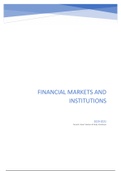FINANCIAL MARKETS AND
INSTITUTIONS
2020-2021
Docent: Geert Gielens & Rudy Vandorpe
,Part I: Fixed income
Introduction
Macro-economic identity
Societies have developed tools and institutions to organise the conditional transfer of “means” from
economic agents that have abundant “means” to economic agents that have a (temporary) need
for/shortage of these “means”.
“Means” should be interpreted as any in that society accepted tool of payment or store of value.
→ fiduciary money
The transfer of the means is bound by a set of rules (conditioned), which are collected in a contract.
Basic condition: the means must be returned to the original owner is some form, at some time in the
future. The rules depend on the type of exchange: loan, bond, cross border or not…
Financial markets and institutions are the operational and practical elaboration of what is behind the
basic macro-economic identity:
𝑌 = 𝐶 + 𝐼 + 𝐺 + (𝑋 − 𝑀)
Consider 𝑌 to be the value of everything that is produced, the production side. We say supply equals
demand, but that’s not always the case. There’s an error to it.
Subtract 𝑇 from both sides
𝑌 − 𝑇 = 𝐶 + 𝐼 + 𝐺 − 𝑇 + (𝑋 − 𝑀)
Transfer 𝐶 to the left side.
𝑌 − 𝑇 − 𝐶 = 𝐼 + (𝐺 − 𝑇) + (𝑋 − 𝑀)
This is equal to 𝑆 = 𝐼 plus some other.
𝑆 = 𝐼 + (𝐺 − 𝑇) + (𝑋 − 𝑀)
How do we get the surplus (savings) to where it is needed (debt in all its forms and equity,
investments)? That is what we are going to figure out in this course.
→ We will discuss the financial plumbing of the economy.
Endogenous system
How financial markets and institutions look is time and place dependent. Systems are not uniform or
constant.
Time dependent
Systems are different from time period to time period. They change over time and it’s important to
keep track of these changes.
Changes:
− Development of the EU.
o With the entry of the euro, other national currencies have disappeared.
o 2012: European Banking union
− Financial crisis of 2008.
− Changes in regulations.
− Technological developments.
− Societal changes.
− The economy itself.
1
Financial markets and institutions: Introduction
,Changes are observable in new products, the disappearance of products, institutions and
corporations that are created or abolished, changing business models, changing means of
payments…
We can expect more radical changes as a result of further European capital markets, Brexit, crypto
and other digital currencies, and technological evolutions.
Geography dependent: there is no unified system in the EU!
Economies and regulations are different in each country. The financial systems adapt to the context,
needs and state of development it works in.
Even within the EU, systems are not homogenized. There are different regulations, interests, pension
systems… We expect that these differences will fade over time.
→ We focus on the Belgian system.
The Belgian financial system
In the graph, we have two countries: A and B.
Starting point: money or a more general means of payment in the hands of economic agents
(consumers, corporations, governments, institutional players). This money is used to transact (buying
or selling).
To execute transactions, we need two things:
− Financial intermediaries or auction systems
o The places where the transactions take place.
o Financial intermediaries:
▪ Bilateral way
▪ Main products: bank loans
▪ They can also directly operate in the capital markets.
▪ Two groups
• Regulated, commercial banks
• Shadow banks
o Auction systems
▪ Multilateral way
▪ Main products: bonds or equity
▪ Exchanges and capital markets
− Payment systems, settlement mechanisms
o Euroclear, Target
o Operational execution of the trades.
o Institutions that assure that the money is paid to the right party and that the assets are
delivered when due on the proper account.
o Subject to financial and technological innovations from the Fin Tech world.
International capital markets
Transactions also happen between countries (or between banks within a given country). This
happens in the (international) capital markets.
There is infrastructure needed to make cross border transactions possible: settlement systems,
specialised guarantors (borgstellers), legal framework.
(Standard) derivatives require the intervention of Central Clearing Parties (CCP).
2
Financial markets and institutions: Introduction
, Regulations
The whole system must be regulated.
− Banking Union of the EU:
o ECB
o Central Banks of each country.
− Belgium: Twin peaks model
o Two institutions responsible for the regulations:
▪ National Bank of Belgium (NBB)
▪ Financial Securities and Market Authority (FSMA).
− International markets:
o International Monetary Fund (IMF)
o Bank for International Settlements (BIS)
o ISDA, ISMA.
Markets
Markets can be physical places (stock exchange), or they can be decentralised and virtualised.
For example, a transaction in the derivatives markets is nothing but two computers in two banks
exchanging bits and bytes (over the counter market).
Summary
A financial system has:
− Money
− Assets also known as “products” (bonds, equity, loans, derivatives, companies, structured
products, commodities...)
− Institutions (banks, capital markets, exchanges, insurance companies, Funds, CCPs…)
− Settlement systems
− Regulators and regulation
3
Financial markets and institutions: Introduction




